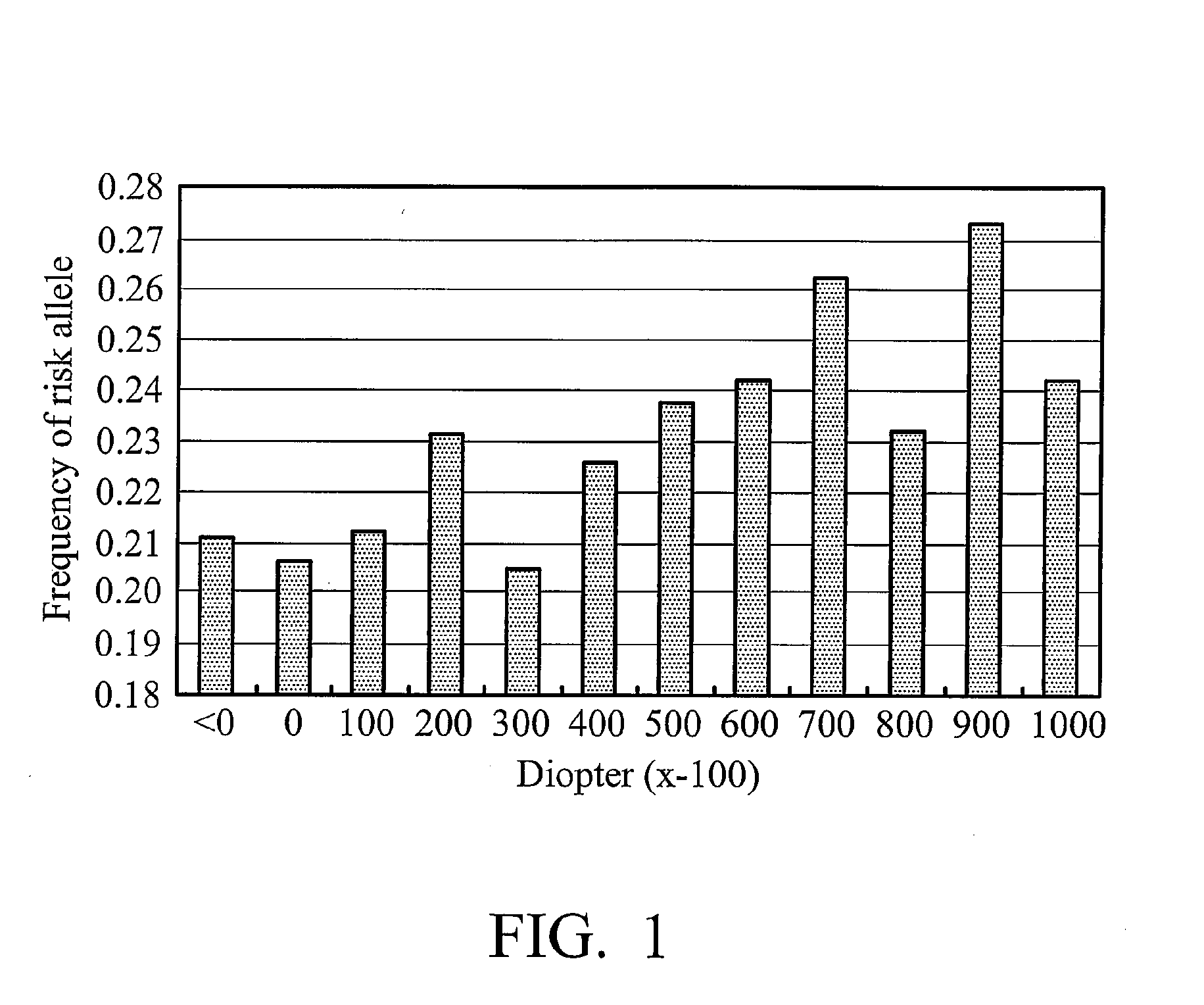Using genetic polymorphisms of the bicd1 gene as a method for diagnosing and treating myopia
a genetic polymorphism and myopia technology, applied in biochemistry, fermentation, organic chemistry, etc., can solve the problems of imposing additional risks to myopes, ocular complications that cannot be prevented, and high identification difficulty, so as to prevent or ameliorate myopia and/or myopia related complications. , to achieve the effect of treating, preventing or ameliorating myopia
- Summary
- Abstract
- Description
- Claims
- Application Information
AI Technical Summary
Benefits of technology
Problems solved by technology
Method used
Image
Examples
example 1
Genome Scan in the Initial Step
[0034]A total of about 4000 subjects were recruited for the myopia study. There were multiple sources for participants, whom included the following: (1) young men in military conscripts, (2) university students, (3) hospital personnel, and (4) patients from ophthalmology clinics. Individuals with spherical refraction≧−6.0 D in one eye and ≦−4.0 D in the other eye were classified as high myopia. A subject was defined as a control if the worse eye had a spherical refraction≧—1.5 D. All subjects were between the ages of 17-45 years old. All the participants were of Chinese descent. All participants gave informed consents. The study was approved by the Institutional Review Board at the Kaohsiung Medical University, Kaohsiung, Taiwan.
[0035]In the initial step, Affymetrix GeneChip® Human Mapping 500K Array Set was used. It comprised two arrays, each capable of genotyping on average 250,000 SNPs (approximately 262,000 for Nsp arrays and 238,000 for Sty arrays...
example 2
Genome Scan in the Second Step
[0038]In the second step, firstly the 10 best SNPs as the centers was used, and a genomic region of 200 kb surrounding each of the 10 best SNPs as our candidate region was selected. A total of 384 tagging SNPs were selected for follow-up fine mapping in independent 1536 subjects whose refraction errors were either −1.5 D. Genotyping was performed by the Illumina BeadArray technology (Sentrix® Array Matrix) (Mutat Res 2005;573:70-82). DNA was annealed to allelic-specific oligonucleotides and amplified by polymerase chain reaction. Array-based hybridization took place and genotyping were achieved by Cy-3 and Cy-5 labeled primers. Thirty replicates of each SNP were done to ensure the highest quality of genotype calling.
[0039]The overall call rate in the second stage was 97.1%. The most significant SNP (rs7966276) was at the BICD1 gene on chromosome 12p11 with a p value −4. Another three SNPs at BICD1 were also significant (SNP rs1151029, p=4.78×10−4; SNP r...
example 3
Genome Scan in the Third Step
[0040]In the third step, the most promising SNPs based on the stage II result were genotyped by using the TaqMan technology (Applied Biosystems [ABI], Foster City, USA). Briefly, PCR primers and TaqMan MGB probes were designed with Primer Express version 2.0. Reactions were performed in 96-well microplates with GeneAmp 9700 thermal cyclers. Fluorescence was measured with an ABI Prism 7500 sequence detection system and analyzed with the ABI Prism 7500 SDS software version 1.0. The subjects with refraction errors between −6 D and −1.5 D were used in the stage III study.
[0041]In the third step, the BICD1 gene was focused and the genetic effect was analyzed using different inheritance models for the three SNPs in a larger dataset including, SNP rs10771923 in 3273 subjects, SNP rs1151029 in 3917 subjects and SNP rs7966276 in 2962 subjects. The allele frequencies of the three SNPs are listed in Table 1. Referring to Table 2, the most significant results were f...
PUM
| Property | Measurement | Unit |
|---|---|---|
| Gene expression profile | aaaaa | aaaaa |
| Fluorescence | aaaaa | aaaaa |
| Chemiluminescence | aaaaa | aaaaa |
Abstract
Description
Claims
Application Information
 Login to View More
Login to View More - R&D
- Intellectual Property
- Life Sciences
- Materials
- Tech Scout
- Unparalleled Data Quality
- Higher Quality Content
- 60% Fewer Hallucinations
Browse by: Latest US Patents, China's latest patents, Technical Efficacy Thesaurus, Application Domain, Technology Topic, Popular Technical Reports.
© 2025 PatSnap. All rights reserved.Legal|Privacy policy|Modern Slavery Act Transparency Statement|Sitemap|About US| Contact US: help@patsnap.com

